February 26, 2000 - Mississippian Fossils, Franklin Co, AL
Every year, the BPS visits a lake in Franklin County, Alabama when the lake level is down from normal, exposing rocks from the Bangor Limestone dating back to the late Mississipian Period of geological history (about 320 million years). About 25 BPS members and guests attended the field trip, which took place on a beautiful, sunny, and pleasantly warm day.
According to Jim Lacefield, the Bangor Limestone formation is "fossiliferous from top to bottom, and collecting sites in it in both Colbert and Franklin Counties are world famous for echinoderms - particularly for crinoids and blastoids - and bryozoans such as Archimedes." Indeed, there are numerous sites in Alabama connected with this formation, and Jim says it is the best rock unit in Alabama for Mississippian fossils, and that few other units are better anywhere for the time frame in question.
We all parked our vehicles along an access road by the lake, and then walked out along the rocky, sandy shoreline. It was in these areas where we found a variety of interesting fossils: blastoids, crinoid stems and loose stem plates, Archimedes spirals, brachiopods, and horn corals. Unfortunately, my camera malfunctioned while I was at the site, so I have no pictures of the lake itself or the sandy shores.
--Edited by Vicki Lais
Fossils were found in two "modes": loose specimens lying in the sand, or encased specimens lying in strong limestone matrix. I show pictures of specimens in both modes here. The first picture shows a variety of blastoids from the sand, up to a penny in size. These were quite common and everyone there found at least a few if they got down on their knees and looked closely at the sand. Much larger blastoids have been found at this site. I recall two years ago how Ken Hoyle picked up a giant blastoid 1-2 inches in length. This kind of blastoid is much rarer than the pieces in the photograph. According to the Fossil Handbook by Rich et al. (1996), blastoids represent stemmed echinoderms whose top sections resemble petrified "nuts". The pieces in the picture represent the calyx of the original animal. Fine details are usually seen in the calyx, such as ridges, a five-fold symmetry, and small holes around the apex representing mouth and possibly anus. | ||
| The second photograph shows a variety of crinoid columns (or stems), some with unusual side holes that I think represent nodes where possibly small branches emerged. Typically these pieces are less than an inch in length, and some have interesting five-petaled flower or star designs on stem plates (columnals) themselves. Even single stem plates could be found in the sand. The third photograph shows loose "Archimedes" spirals or corkscrews. These represent a type of animal known as a bryozoan, or moss animal. Archimedes spirals are members of a group of bryozoa known as Cryptostomata, that includes the lacey grid-like fossils seen on other larger rocks from the same site. The two features were part of the same animal according to the Fossil Handbook. The authors of the Fossil Handbook state that the combination of a lacey support and a central column in the form of a wide-flanged corkscrew was an efficient feeding arrangement. | 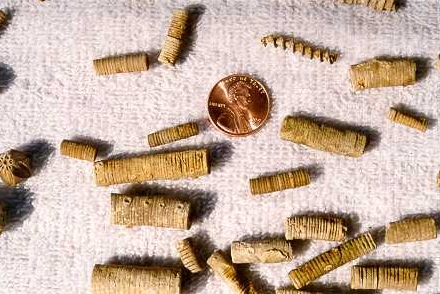 |
| Fig. 2 - examples of short sections of crinoid stalks, some with nodal holes. | |
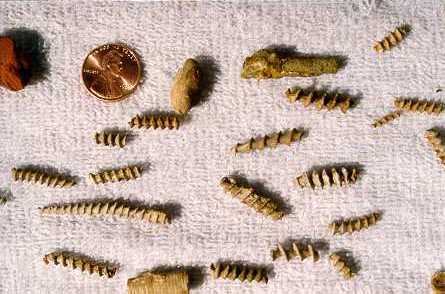 | |
| Fig. 3 - examples of Archimedes corkscrew bryozoa. |
| The fourth photograph shows a variety of small horn corals. According to the Fossil Handbook, these belong to the group Rugosa because their surface is marked by wrinkles. Most of the pieces I found were weathered and in poor condition. | 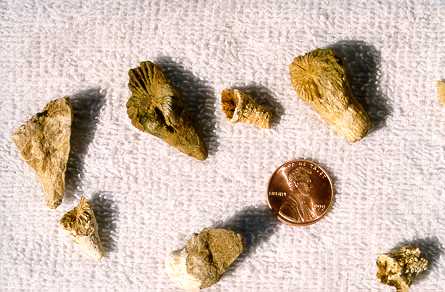 |
| Fig. 4 - examples of small Rugosan horn corals. | |
| The remaining photographs show a variety of small brachiopods, Archimedes spirals and crinoid stem plates encased in a limestone matrix. The last picture is typical of many Mississipian rocks in northwest Alabama: showing hundreds of loose crinoid stem plates. Although I was able to stay at the site for only an hour and a half, it was still possible to find many interesting specimens. Unfortunately, I missed the highlight of the trip: a visit to the home of Jim and Faye Lacefield in Tuscumbia. It was very kind of Jim and Faye to invite the BPS to their home, and I heard from those who went that it was a very nice experience. | 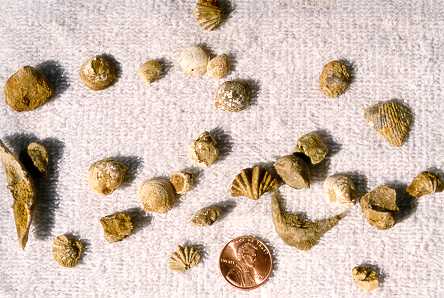 |
| Fig. 5 - examples of small brachiopods. |
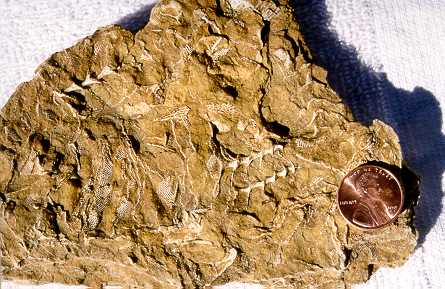 | |
| Fig. 6 - rock with two strong Archimedes spirals encased. | |
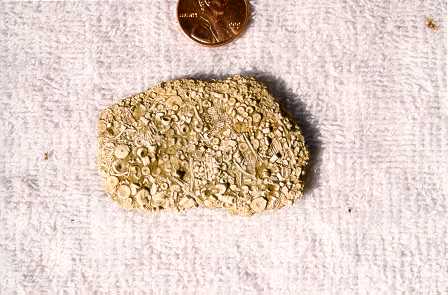 | |
| Fig. 7 - piece covered with crinoid stem plates and bryozoa. |
The BPS will continue to visit this area, probably at least once a year. The possibility of finding interesting Mississippian fossils is always present at this site, and it is a trip worth looking forward to each year.

